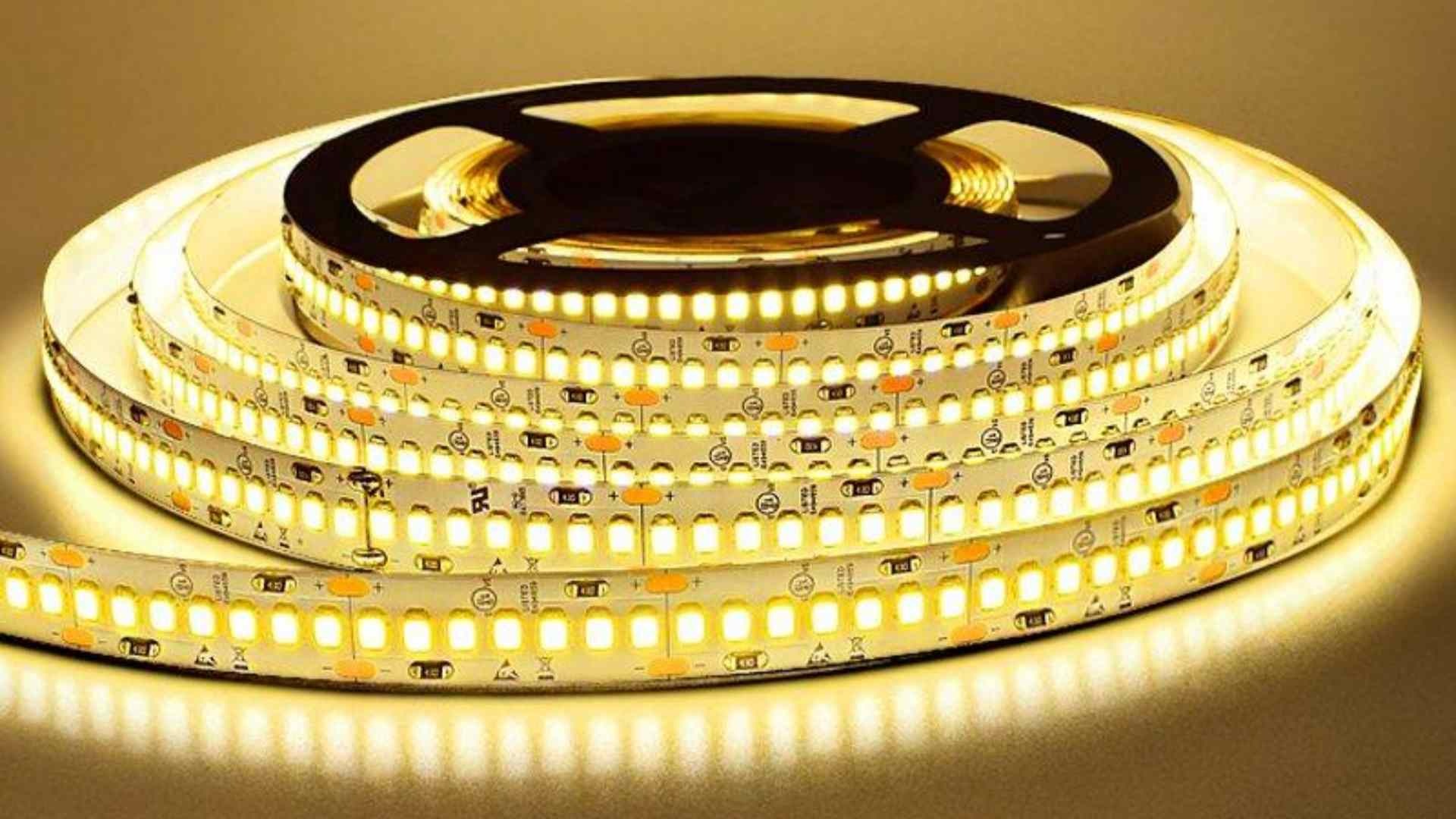ьЋюЖхГВЮў
LED ВіцьіИвдй ВА░вфЁВЮђ ьўёвїђ ВА░вфЁ вћћВъљВЮИВЮў ьЋёВѕўьњѕВЮ┤ вљўВЌѕВіхвІѕвІц. вІцВъгвІцвіЦьЋўЖ│а, ьЎћвацьЋўвЕ░, ВёцВ╣ўЖ░ђ Ж░ёьјИьЋЕвІѕвІц. ьЋўВДђвДї ВъљВБ╝ вг╗віћ ВДѕвгИВЮ┤ ьЋўвѓў ВъѕВіхвІѕвІц. LED ВіцьіИвдйВЮђ ВаёваЦВЮё вДјВЮ┤ ВєївфеьЋаЖ╣їВџћ?
Ж░ёвІеьъѕ вДљьЋ┤Вёю, ВЋёвІѕВџћ. ВѓгВІц LED ВіцьіИвдй ВА░вфЁВЮђ Вўцвіўвѓа Ж░ђВъЦ ВЌљвёѕВДђ ьџеВюеВаЂВЮИ ВА░вфЁ ВўхВЁў ВцЉ ьЋўвѓўВъЁвІѕвІц. вг┤вЊю ВА░вфЁ, В║љв╣ёвІЏ ьЋўвХђ ВА░вфЁ, Ж░ёьїљ, вїђьўЋ ВЃЂВЌЁВџЕ вћћВіцьћїваѕВЮ┤ вЊ▒ Вќ┤вќц ВџЕвЈёвАю ВѓгВџЕьЋўвЊа LED ВіцьіИвдйВЮђ ВхюВєїьЋюВЮў ВаёваЦвДї ВєївфеьЋўвЕ┤Вёю вєњВЮђ в░ЮЖИ░вЦ╝ ВаюЖ│хьЋўвЈёвАЮ ВёцЖ│ёвљўВЌѕВіхвІѕвІц.
LED ВіцьіИвдйВЮ┤ ВІцВаювАю Вќ┤вќ╗Ж▓ї ВъЉвЈЎьЋўвіћВДђ, ВЌљвёѕВДђ ВѓгВџЕВЌљ ВўЂьќЦВЮё в»ИВ╣ўвіћ ВџћВЮИВЮђ вг┤ВЌЄВЮИВДђ, ВІцВаю ВЃЂьЎЕВЌљВёю ВўѕВЃЂьЋа Вѕў Въѕвіћ Вєїв╣ёвЪЅВЮђ Вќ┤вќцВДђ ВЋїВЋёв│┤Ж▓аВіхвІѕвІц.

LED ВіцьіИвдйВЮў ВаёваЦ ВѓгВџЕвЪЅВЮђ ВБ╝вАю в»Иьё░вІ╣ ВЎђьіИ ВѕўвАю Ж▓░ВаЋвљЕвІѕвІц. ьўёВъг ВІюВцЉВЌљ ьїљвДцвљўвіћ вїђвХђвХёВЮў LED ВіцьіИвдйВЮђ LED в░ђвЈёВЎђ ВіцьіИвдйВЮў Ваёв░ўВаЂВЮИ вћћВъљВЮИВЌљ вћ░вЮ╝ в»Иьё░вІ╣ 4~15ВЎђьіИвЦ╝ Вєїв╣ёьЋЕвІѕвІц.
Ж│аВХюваЦ ВўхВЁўВА░В░евЈё ЖИ░ВА┤ ВА░вфЁВЌљ в╣ёьЋ┤ ВЃЂвїђВаЂВю╝вАю ВаёваЦ ВєївфевЪЅВЮ┤ ВаЂВіхвІѕвІц. ВўѕвЦ╝ вЊцВќ┤, ВЮ╝в░ў в░▒ВЌ┤ВаёЖхгвіћ в»Иьё░вІ╣ 60WВЮў ВаёваЦВЮё ВєївфеьЋўвіћ в░ўвЕ┤, 9.6W LED ВіцьіИвдйВЮђ в»Иьё░вІ╣ в╣ёВіиьЋю ВќЉВЮў в╣ЏВЮё вЃЁвІѕвІц.
в░▒ВЌ┤ВаёЖхг, ьЋавАюЖ▓љВаёЖхг, CFLВаёЖхгВЎђ Ж░ЎВЮђ ЖИ░ВА┤ ВА░вфЁЖ│╝ в╣ёЖхљьќѕВЮё вЋї, LED ВіцьіИвдйВЮђ ьџеВюеВё▒ вЕ┤ВЌљВёю ьЏеВћг ВЋъВёювѓўЖ░ЉвІѕвІц.
вІцВЮїВЮђ ВЎђьіИвІ╣ вБевЕўВЌљ вћ░вЦИ ВА░вфЁ ВўхВЁўВЮў ВёИвХђ вѓ┤ВџЕВъЁвІѕвІц.
| Ж┤ЉВЏљ | ьџеВюе(ВЎђьіИвІ╣ вБевЕў) |
| в░▒ВЌ┤ВаёЖхг | 10РђЊ17 |
| ьЋавАюЖ▓љ ВаёЖхг | 15РђЊ25 |
| CFL | 35РђЊ60 |
| LED ВіцьіИвдй(Ж│аЖ┤ЉвЈё ВХюваЦ) | 80РђЊ110+ |
ВЌљВЮ┤ ьЋўВЮ┤вЮ╝ВЮ┤ьіИ LED ВіцьіИвдй ВА░вфЁ ВЎђьіИвІ╣ 100вБевЕў ВЮ┤ВЃЂВЮё ВЅйЖ▓ї ВаёвІгьЋа Вѕў ВъѕВќ┤ Вєїв╣ёвљўвіћ ВаёЖИ░ вІеВюёвІ╣ вЇћ вДјВЮђ Ж░ђВІюЖ┤ЉВёа ВХюваЦВЮё Вќ╗ВЮё Вѕў ВъѕВіхвІѕвІц.
ВўѕвЦ╝ вЊцВќ┤ 5m ЖИИВЮ┤ВЮў ВіцьіИвдйВЮё ВѓгВџЕьЋювІцЖ│а Ж░ђВаЋьЋ┤ в│┤Ж▓аВіхвІѕвІц. Ж│ав░ђвЈё В╗гвЪгьњђ LED вЮ╝ВЮ┤ьіИ ВіцьіИвдй в»Иьё░вІ╣ 9.6WвАю ВаЋЖ▓ЕьЎћвљўВќ┤ ВъѕВіхвІѕвІц. вћ░вЮ╝Вёю В┤Ю ВаёваЦ ВѓгВџЕвЪЅВЮђ вІцВЮїЖ│╝ Ж░ЎВіхвІѕвІц.
5в»Иьё░ ├Ќ 9.6W = 48W
ВЮ┤ ВіцьіИвдйВЮё ьЋўвБе 5ВІюЖ░ёВћЕ ВІцьќЅьЋўвЕ┤:
48W ├Ќ 5ВІюЖ░ё = ьЋўвБе 240ВЎђьіИВІю
= ьЋўвБе 0.24kWh
в»ИЖхГВЌљВёю kWhвІ╣ 0.13вІгвЪгВЮў ьЈЅЖиа ВаёЖИ░ ВџћЖИѕВЮё ЖИ░ВцђВю╝вАю ьЋўвБе в╣ёВџЕВЮђ вІцВЮїЖ│╝ Ж░ЎВіхвІѕвІц.
0.24 ├Ќ 0.13вІгвЪг = 0.031вІгвЪг
ВЮ┤віћ Ж│хЖ░ёВЮё Жи╣ВаЂВю╝вАю Ж░юВёаьЋўвіћ ВА░вфЁВЌљ ьЋю вІгВЌљ ВЋй 0.93вІгвЪгЖ░ђ вЊавІцвіћ ВЮўв»ИВъЁвІѕвІц.
ВЮ┤Ваю ВЮ┤Ж▓ЃВЮё 60W в░▒ВЌ┤ВаёЖхг 5Ж░юВЎђ в╣ёЖхљьЋ┤ в│┤ВёИВџћ.
ВаёЖхг 5Ж░ю ├Ќ 60W ├Ќ 5ВІюЖ░ё = 1500ВЎђьіИВІю = 1.5kWh/ВЮ╝
1.5 ├Ќ $0.13 = $0.195/ВЮ╝ = $5.85/ВЏћ
LED ВіцьіИвдйВю╝вАю в░ћЖЙИвіћ Ж▓ЃвДїВю╝вАювЈё ВаёЖИ░ в╣ёВџЕВЮё ВЋй 85% ВаѕВЋйьЋа Вѕў ВъѕВіхвІѕвІц.
LED ВіцьіИвдйВЮђ в│ИВДѕВаЂВю╝вАю ВЌљвёѕВДђ ьџеВюеВаЂВЮ┤ВДђвДї ВІцВаю ВаёЖИ░ ВѓгВџЕвЪЅВЮђ вфЄ Ж░ђВДђ ВџћВЮИВЌљ вћ░вЮ╝ вІгвЮ╝ВДѕ Вѕў ВъѕВіхвІѕвІц.
LED в░ђвЈё
в»Иьё░вІ╣ LED ВѕўЖ░ђ вДјВЮёВѕўвАЮ ВЮ╝в░ўВаЂВю╝вАю в░ЮЖИ░Ж░ђ вєњВЋёВДђЖ│а ВаёваЦ ВѓгВџЕвЪЅвЈё віўВќ┤вѓЕвІѕвІц. в»Иьё░вІ╣ 60Ж░юВЮў LEDвЦ╝ ВѓгВџЕьЋўвіћ ВіцьіИвдйВЮђ в»Иьё░вІ╣ 120Ж░юВЮў LEDвЦ╝ ВѓгВџЕьЋўвіћ ВіцьіИвдйв│┤вІц ВаёваЦ ВєївфевЪЅВЮ┤ ВаЂВіхвІѕвІц.
ВЃЅВЃЂ в░Ј ьџеЖ│╝
В╗гвЪг В▓┤ВЮ┤ВІ▒ВЮ┤вѓў Ж╣юв╣АВъёЖ│╝ Ж░ЎВЮђ вЈЎВаЂ ЖИ░віЦВЮђ вІеВЃЅ Ж│аВаЋ ВА░вфЁВЌљ в╣ёьЋ┤ ВаёваЦ ВєївфевЪЅВЮё ВЋйЖ░ё ВдЮЖ░ђВІюьѓхвІѕвІц. ЖиИвЪгвѓў RGB ЖИ░віЦВЮё вфевЉљ Ж░ќВХў ВЌљвёѕВДђ ВаѕВЋйьўЋ В╗гвЪг LED ВіцьіИвдй ВА░вфЁвЈё вїђвХђвХёВЮў Ж▓йВџ░ 5W/m в»ИвДїВЮё ВюаВДђьЋЕвІѕвІц.
ВаёВЋЋ в░Ј ВаёВЏљ Ж│хЖИЅ
вїђвХђвХёВЮў LED ВіцьіИвдйВЮђ 12V вўљвіћ 24V DCвАю ВъЉвЈЎьЋЕвІѕвІц. ВаЂВаѕьЋю ВаёВЏљ Ж│хЖИЅ ВъЦВ╣ўвЦ╝ ВѓгВџЕьЋўвЕ┤ ьџеВюеВЮ┤ в│┤ВъЦвљЕвІѕвІц. ВађВаёВЋЋ вўљвіћ Ж│╝ВаёВЋЋ ВЃЂьЃювіћ ьџеВюе ВађьЋў вўљвіћ ВіцьіИвдй ВєљВЃЂВю╝вАю ВЮ┤Вќ┤ВДѕ Вѕў ВъѕВіхвІѕвІц.
ВаюВќ┤ ВІюВіцьЁю
ВА░Ж┤ЉЖИ░, вфеВЁў Вё╝Вёю, ВіцвДѕьіИ В╗еьіИвАцвЪгвЦ╝ ВѓгВџЕьЋўвЕ┤ в░ЮЖИ░ВЎђ ВѓгВџЕ ВІюЖ░ёВЮё вДъВХцьЎћьЋўВЌг ВаёваЦ ВѓгВџЕвЪЅВЮё вЇћВџ▒ ВцёВЮ╝ Вѕў ВъѕВіхвІѕвІц.
[вЂЮ] ВаёваЦ ВѓгВџЕвЪЅВЮё ВхюВєїьЎћьЋўвіћ Ж▓ЃВЮ┤ ВхюВџ░Вёа ВѕюВюёвЮ╝вЕ┤ вІцВЮїЖ│╝ Ж░ЎВЮ┤ Вўгв░ћвЦИ LED ВіцьіИвдйВЮё ВёаьЃЮьЋўВёИВџћ.
ВёаьЃЮьЋўвІц ВЌљвёѕВДђ ВаѕВЋйьўЋ В╗гвЪг LED ВіцьіИвдй ВА░вфЁ ВБ╝в│ђ ВА░вфЁВЮё ВюёьЋ┤.
ВЮ┤ ВіцьіИвдйВЮђ Ж│аВХюваЦ вїђВ▓┤ ВаюьњѕВЮў ВЌљвёѕВДђ Вєївфе ВЌєВЮ┤ ВЋёвдёвІцВџ┤ ВА░вфЁВЮё ВаюЖ│хьЋЕвІѕвІц.
ВДёВЌ┤ВъЦВЮ┤вѓў Ж░ёьїљВ▓ўвЪ╝ ЖиаВЮ╝ьЋю ВА░вфЁ вХёьЈгЖ░ђ ВцЉВџћьЋю Ж▓йВџ░, Ж│ав░ђвЈё В╗гвЪг LED ВіцьіИвдйВЮё ВѓгВџЕьЋўВёИВџћ. ВаЂвІ╣ьЋю ВаёваЦ ВѓгВџЕвЪЅВю╝вАю ВЮ╝Ж┤ђвљю в░ЮЖИ░вЦ╝ Вќ╗ВЮё Вѕў ВъѕВіхвІѕвІц.
ВъЉВЌЁВъЦВЮ┤вѓў ВЃЂВЌЁ ВІюВёцВ▓ўвЪ╝ вєњВЮђ в░ЮЖИ░Ж░ђ ьЋёВџћьЋю Ж▓йВџ░ВЌљвДї ьЋўВЮ┤вЮ╝ВЮ┤ьіИ LED ВіцьіИвдй ВА░вфЁВЮё ВёаьЃЮьЋўВёИВџћ. в»Иьё░вІ╣ ВЌљвёѕВДђ Вєїв╣ёвЪЅВЮђ вЇћ вєњВДђвДї, вБевЕў ВХюваЦВЮ┤ ьЏеВћг вєњВЋё ВЌгвЪг Ж░юВЮў ВА░вфЁВЮё ВёцВ╣ўьЋа ьЋёВџћЖ░ђ ВЌєВіхвІѕвІц.
LED ВіцьіИвдйВЮ┤ ьЋГВЃЂ ВхюВёаВЮў ВёаьЃЮВЮ╝Ж╣їВџћ?
вїђвХђвХёВЮў Ж▓йВџ░, вІхВЮђ 'Вўѕ'ВъЁвІѕвІц. LED ВіцьіИвдйВЮђ в░юВЌ┤ВЮ┤ ВаЂЖ│а ВѕўвфЁВЮ┤ ЖИИвЕ░(в│┤ьєх 25,000~50,000ВІюЖ░ё), ьџеВюеВё▒ВЮ┤ вДцВџ░ вЏ░Вќ┤вѓЕвІѕвІц. Вхювїђ в░ЮЖИ░ВЌљВёювЈё в╣ёВіиьЋю Ж┤ЉВХюваЦВЮё Ж░ђВДё вІцвЦИ ВА░вфЁ ЖИ░Вѕав│┤вІц ВаёваЦ ВєївфевЪЅВЮ┤ ьЏеВћг ВаЂВіхвІѕвІц.
ВЌљвёѕВДђ Вєїв╣ёвЦ╝ ВцёВЮ┤вЕ┤Вёю ВБ╝в░Е ВѕўвѓЕВъЦ ьЋўвХђ ВА░вфЁ, В╣еВІц вХёВюёЖИ░ ВЌ░ВХю, вДцВъЦ вћћВіцьћїваѕВЮ┤ в░▒вЮ╝ВЮ┤ьіИ вЊ▒ ВЃЮвЈЎЖ░љ вёўВ╣ўвіћ Ж│хЖ░ёВЮё ВЌ░ВХюьЋўЖ│а ВІХвІцвЕ┤ LED ВіцьіИвдйВЮ┤ ьЎЋВІцьЋю ьЋ┤Ж▓░В▒ЁВъЁвІѕвІц. ьЋўВЮ┤вЮ╝ВЮ┤ьіИ LED ВіцьіИвдй ВА░вфЁЖ│╝ Ж│ав░ђвЈё В╗гвЪг LED ВА░вфЁ ВіцьіИвдйЖ│╝ Ж░ЎВЮђ ВхюВІа ЖИ░ВѕаВЮё ВѓгВџЕьЋўвЕ┤ ВаёЖИ░ ВџћЖИѕ вХђвІ┤ ВЌєВЮ┤ Ж░ЋваЦьЋю в░ЮЖИ░вЦ╝ ВдљЖИИ Вѕў ВъѕВіхвІѕвІц.